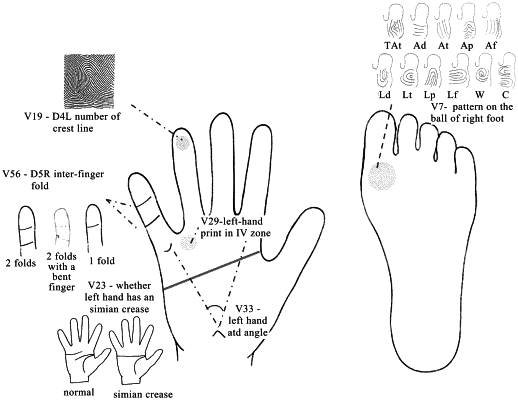| CPC A61B 5/7275 (2013.01) [A61B 5/0064 (2013.01); A61B 5/1172 (2013.01); A61B 5/1174 (2013.01); A61B 2503/04 (2013.01); A61B 2503/06 (2013.01)] | 12 Claims |

|
1. An early assisted screening system for Down syndrome, which comprises:
(a) a skin print feature input module, which is configured to input skin print features of a subject; wherein the skin print features comprise V7—pattern on the ball of right foot, V33—left hand atd angle, and V56—right hand D5R inter-finger fold(s);
(b) a processing module for diagnosis of Down syndrome based on skin print, wherein the processing module performs a scoring processing on the inputted skin print features according to a predetermined evaluation criteria to obtain a risk score, and compares the risk score with a Down syndrome risk threshold, thereby obtaining an assisted screening result; wherein, when the risk score is higher than the risk threshold, it indicates that the subject's risk of Down syndrome is higher than that of a normal population; and when the risk score is lower than the risk threshold, it indicates that the subject's risk of Down syndrome is lower than that of the normal population; and
(c) an output module for assisted screening result, which is configured to output the assisted screening result,
wherein in the processing, a risk score processing is performed as follows:
V7—pattern on the ball of right foot: when the arch print is present, the risk of disease increases;
V33—left hand atd angle: when the angle is greater than 50 degrees, the risk of disease increases; and
V56—D5R inter-finger fold: when there is only one inter-finger fold or the little finger is bent, the risk of disease increases.
|